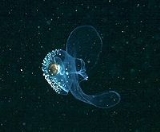
Cavolinioidea
Encyclopedia
The superfamily
Cavolinioidea is the most speciose group of sea butterflies. Sea butterflies (thecosomata) are pelagic marine
gastropods, so called because they swim by flapping their wing-like parapodia.
, bilaterally symmetrical conical or globular shell. Identification of juveniles is difficult as the juvenile shells differ greatly from adults.
, which produce a minute water current that pushes the plankton
ic food to the mouth of the animal.
s and then later convert into females. More than one male stage can occur. This bizarre-seeming, but not very uncommon phenomenon is called protandry
. (This is also common among many species of fish, some may all start as females, others species may start as males.)
(2005) several families have been categorized as subfamilies of the family Cavoliniidae and the superfamily Cavolinioidea is treated like this:
In 2005 a new family Praecuvierinidae
Janssen, 2005 was created on evolutionary grounds.
Taxonomic rank
In biological classification, rank is the level in a taxonomic hierarchy. Examples of taxonomic ranks are species, genus, family, and class. Each rank subsumes under it a number of less general categories...
Cavolinioidea is the most speciose group of sea butterflies. Sea butterflies (thecosomata) are pelagic marine
Marine (ocean)
Marine is an umbrella term. As an adjective it is usually applicable to things relating to the sea or ocean, such as marine biology, marine ecology and marine geology...
gastropods, so called because they swim by flapping their wing-like parapodia.
Distribution
These sea butterflies are circumglobal, carried by the sea currents to all the seas of the world.Habitat
Cavoliniids prefer deep waters, from 100 m up to 2,000 m. They do best in warm oceanic water.Shell description
Species in this superfamily have a calcareousCalcareous
Calcareous is an adjective meaning mostly or partly composed of calcium carbonate, in other words, containing lime or being chalky. The term is used in a wide variety of scientific disciplines.-In zoology:...
, bilaterally symmetrical conical or globular shell. Identification of juveniles is difficult as the juvenile shells differ greatly from adults.
Life habits
Towards the anterior end of the animal, two parapodia (winglike flat lobules) protrude between each half of the shell. The parapodia enable these sea butterflies to float along in the water currents, using slow flapping movements. The parapodia are also covered with ciliaCilium
A cilium is an organelle found in eukaryotic cells. Cilia are slender protuberances that project from the much larger cell body....
, which produce a minute water current that pushes the plankton
Plankton
Plankton are any drifting organisms that inhabit the pelagic zone of oceans, seas, or bodies of fresh water. That is, plankton are defined by their ecological niche rather than phylogenetic or taxonomic classification...
ic food to the mouth of the animal.
Reproduction
Cavoliniids have a strange sexual life. They develop from males as juveniles into hermaphroditeHermaphrodite
In biology, a hermaphrodite is an organism that has reproductive organs normally associated with both male and female sexes.Many taxonomic groups of animals do not have separate sexes. In these groups, hermaphroditism is a normal condition, enabling a form of sexual reproduction in which both...
s and then later convert into females. More than one male stage can occur. This bizarre-seeming, but not very uncommon phenomenon is called protandry
Hermaphrodite
In biology, a hermaphrodite is an organism that has reproductive organs normally associated with both male and female sexes.Many taxonomic groups of animals do not have separate sexes. In these groups, hermaphroditism is a normal condition, enabling a form of sexual reproduction in which both...
. (This is also common among many species of fish, some may all start as females, others species may start as males.)
Taxonomy
In 2003, the family Cavoliniidae was raised to the rank of superfamily Cavolinioidea. At the same time, the subfamilies were given the new status of families: Cavoliniidae, Cliidae, Creseidae and Cuvierinidae (Cainozoic Research, 2(1-2): 163-170, 2003).2005 taxonomy
In the taxonomy of Bouchet & RocroiTaxonomy of the Gastropoda (Bouchet & Rocroi, 2005)
The taxonomy of the Gastropoda as it was revised by Philippe Bouchet and Jean-Pierre Rocroi is currently the most up-to-date overall system for classifying gastropod mollusks...
(2005) several families have been categorized as subfamilies of the family Cavoliniidae and the superfamily Cavolinioidea is treated like this:
- Family CavoliniidaeCavoliniidaeThe family Cavoliniidae is a taxonomic group of small floating sea snails, pelagic marine opisthobranch gastropod mollusks. This family is part of a larger group which is commonly known as the sea butterflies because they swim by flapping what appear to be small "wings".-Distribution:This family of...
Gray, 1850 (1815)- Subfamily Cavoliinae Gray, 1850 (1815) - formerly Hyalaeidae Rafinesque, 1815
- Subfamily Clioinae Jeffreys, 1869 - formerly Cleodoridae Gray, 1840 - nomen oblitum
- Subfamily Cuvierininae van der Spoel, 1967 - formerly: Cuvieriidae Gray, 1840 (nom. inv.); Tripteridae Gray, 1850
- Subfamily Creseinae Curry, 1982
- Family LimacinidaeLimacinidaeLimacinidae is a family of small sea snails, pteropods, pelagic marine gastropod mollusks in the clade Thecosomata .-Genera:Genera within the family Limacinidae include:...
Gray, 1840 formerly: Spirialidae Chenu, 1859; Spiratellidae Dall, 1921 - † Family SphaerocinidaeSphaerocinidaeSphaerocinidae is an extinct taxonomic family of sea snails and sea slugs, marine opisthobranch gastropod mollusks within the informal group Opisthobranchia....
A. Janssen & Maxwell, 1995
In 2005 a new family Praecuvierinidae
Praecuvierinidae
Praecuvierinidae is a family of extinct of small floating sea snails, pelagic marine opisthobranch gastropod mollusks in the superfamily Cavolinioidea.- Genera :* Genus Praecuvierina Janssen, 2005...
Janssen, 2005 was created on evolutionary grounds.

